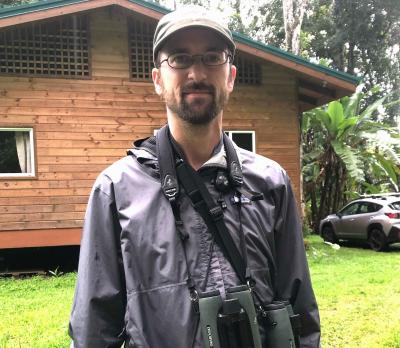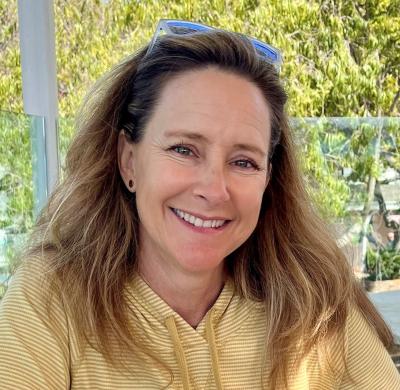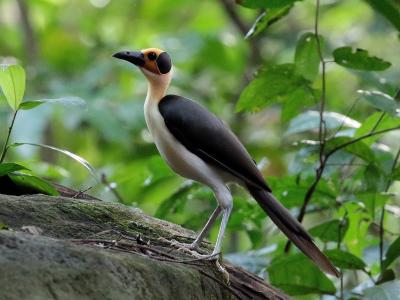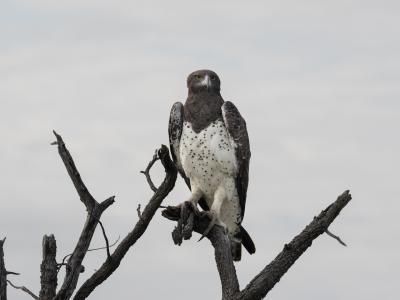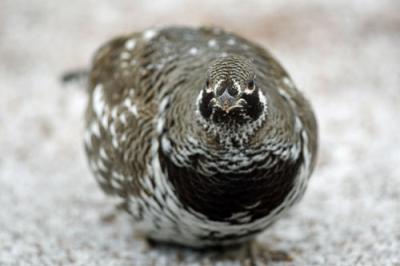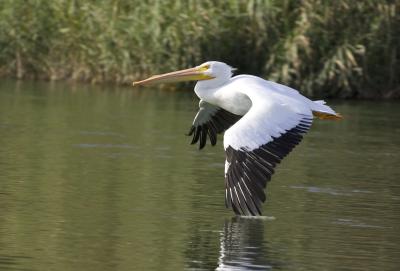Northwest Ohio: Spring Migration
-
May 13-19, 2026
Ethan Kistler
2026
Single Room Supplement $690
2026
Single Room Supplement $690
Branded as the “Warbler Capital of the World”, Northwest Ohio and the famous Magee Marsh boardwalk are one of the best areas to witness spring migration in North America! The convergence of several migration routes, the bird-blocking effect of Lake Erie, and a fine mix of habitats combine to produce a remarkable number and diversity of Neotropical migrants. Nearly all woodlots will be filled with song as breeding males closer to their northern breeding grounds. Raptors and shorebirds should also be passing through in numbers, while we will be able to catch up with a good number of lingering waterfowl as well. This is a migration spectacle well worth experiencing!
In addition to Magee Marsh, we’ll visit a number of other productive and less crowded birding sites including Ottawa National Wildlife Refuge, Metzger and Howard Marshes, Pearson Metropark, Oak Openings Preserve, and—in southeast Michigan—Pointe Mouillee. Most days we’re likely to encounter more than one hundred species and we hope to see 30 species of warbler before the tour concludes.
Day 1: The trip begins at 6:00 p.m. in our hotel near the Detroit Metro Airport with a brief meeting followed by dinner. Night near Detroit Metro Airport.
Day 2: We’ll depart early for Pointe Mouillee State Game Area just north of the Ohio border. This 4,000-acre coastal wetland complex borders Lake Erie at the mouth of the Huron River and is a magnet for waterfowl, waterbirds, and shorebirds. If we hit it right, we should see hundreds of Dunlin and perhaps Short-billed Dowitcher and Black-bellied Plover among others. Black Tern, American White Pelican, and Yellow-headed Blackbird are locally uncommon, and we’ll keep an eye out for them. We’ll make several more stops en-route to Ohio, targeting Bobolink among others. In the late afternoon, we’ll check into our hotel and, if time permits, bird a local park before dinner. Night in Oregon, Ohio.
Days 3-5: With Oregon as our home base, we’ll spend the next three days birding countless hotspots in northwest Ohio. We’ll remain flexible as weather, winds, and bird reports will largely control when and where to bird. Our main stop will be the Magee Marsh boardwalk where sighting more than twenty species of warblers in a single day is not out of the question. We’ll also hope to see various species of vireos, flycatchers, thrushes, and cuckoos. We will also bird nearby productive woodlots such as Metzger Marsh, Ottawa National Wildlife Refuge, Pearson Metropark, and the Maumee Bay State Park boardwalk, keeping our eyes to the skies for migrating raptors—most notably Broad-winged Hawks. We’ll also bird several wetlands and flooded fields for waterfowl and shorebirds, especially Howard Marsh, which is a metropark that was only recently converted from farmlands to 1,000 acres of prime wetland habitat and has attracted nesting Black-necked Stilts, Wilson’s Phalaropes, and Yellow-headed Blackbirds—all three of which are rare breeders in Ohio! We’ll also search for American Pipit, Marsh Wren, and lingering ducks. An hour east, we’ll spend one morning birding a beautiful eastern hardwood forest where Cerulean and Yellow-throated Warblers breed. Rare near Magee, these local breeders are quite reliable at this local metropark and we will also keep an eye out for a few other resident breeders such as Acadian Flycatcher and Wood Thrush. One evening we’ll offer an optional night-birding excursion for rails,bitterns, and Eastern Whip-poor-will. Nights in Oregon.
Day 6: We’ll depart early for the forty-five-minute drive to Toledo’s largest Metropark, Oak Openings Preserve. This 5,000-acre park is predominately oak savanna which contains oak forest, grasslands, and vegetated sand dunes. Wild lupine blankets the forest floors while prickly pear and sand cherries grow on the shifting dunes. Our main targets are birds we won’t find elsewhere: Barred Owl, Pileated Woodpecker, Lark Sparrow, Blue Grosbeak, Summer Tanager, Henslow’s Sparrow, and Yellow-breasted Chat. Red-headed Woodpeckers are abundant, and we should be able to pick up a good selection of Neotropical migrants. After a full day of birding Oak Openings and its surroundings, we’ll make our way to Detroit. Night in Detroit.
Day 7: The tour concludes this morning in Detroit.
Note: The information presented below has been extracted from our formal General Information for this tour. It covers topics we feel potential registrants may wish to consider before booking space. The complete General Information for this tour will be sent to all tour registrants and of course supplemental information, if needed, is available from the WINGS office.
ENTERING THE UNITED STATES: Non-United States citizens will need a valid passport and may need a tourist visa. Consult your nearest U.S. Embassy or consulate for details.
PACE OF TOUR: The tour is moderately strenuous, with long days, early departures, and moderate walks. Most mornings we’ll depart before dawn or shortly thereafter. There may be a few afternoon breaks other than driving between spots. Most days we try to end our birding about 6:00 p.m. We may on occasion offer additional birding after dinner. Still, we often don’t retire until after 9:00 p.m. so this tour can be tiring. The terrain is fairly level throughout. On a few occasions, there will be the option of resting in the hotel rather than birding. However, if one has trouble walking, this tour will be difficult.
Bathroom Breaks: Restroom stops will be available at regular intervals throughout the day, and facilities are present at most birding sites we visit on this tour.
HEALTH: Ohio and Michigan present no real hazards to the visiting birdwatcher.
Insects and Arachnids: Biting insects are occasionally a problem in northern Michigan and possibly elsewhere if it is a very early spring. It is best to have bug repellent along just in case. We recommend using insect repellents with a high concentration of DEET. Care must be taken, however, to avoid getting the DEET repellent on optical equipment as DEET dissolves rubber and plastic and can damage coated lenses. Camping supply stores and outfitters carry some reasonably effective alternatives, which contain natural products and aren’t corrosive.
Dog ticks are present in numbers in grassland areas throughout and it is best to check yourself carefully if we walk into a field. These large ticks are readily visible, unlike the smaller deer ticks, and usually take their time before trying to attach, so careful inspections after walking in tick areas is well advised. It is unclear how effective repellent is in keeping them off you.
Smoking: Smoking is prohibited in the vehicles or when the group is gathered for meals, checklists, etc. If you are sharing a room with a nonsmoker, please do not smoke in the room. If you smoke in the field, do so well away and downwind from the group. If any location where the group is gathered has a stricter policy than the WINGS policy, that stricter policy will prevail.
CLIMATE: Mid-May weather in the Midwest can be extremely variable with temperatures possibly ranging from the mid-30s (even high 20s) to the high 80s F. Some rain, occasionally much rain (rarely snow!), is likely during the course of the week as various weather systems pass through and it can be windy as well. Bring warm clothes!
FOOD: Food is North American standard. Lunches will be a mix of picnics (as weather permits) and quick service restaurants.
WINGS tours are all-inclusive, and with the exception of WINGS tours to destinations in the US, no refunds can be issued for any tour meals participants choose to skip.
Food Allergies / Requirements: We cannot guarantee that all food allergies can be accommodated at every destination. Participants with significant food allergies or special dietary requirements should bring appropriate foods with them for those times when their needs cannot be met. Announced meal times are always approximate depending on how the day unfolds. Participants who need to eat according to a fixed schedule should bring supplemental food. Please contact the WINGS office if you have any questions.
TRANSPORTATION: We will be traveling by 15- [or 12-] passenger window van or minivan, depending on the group size. When using 15-passenger window vans, we will take a maximum of seven passengers plus the leader/driver. Participants should be able to ride in any seat in our tour vehicles.
PHOTOGRAPHY: Scenery and memory shots will be plentiful and simple to obtain but birds are difficult to photograph, though conditions at Magee Marsh and nearby areas provide outstanding opportunities to photograph migrant eastern birds. We suggest a digital camera or a 35mm camera for scenes and for chance
bird photographs. A telephoto lens is virtually essential for bird photography. “Digiscoping” is perfectly compatible with the tour, though you should bring your own telescope. If you are a serious photographer, please contact us for further information about photography on a birding tour. Camera equipment should be packed in moisture- and dust-proof bags, as a precaution.
2024 Narrative
In Brief
Spring migration in the US is a world-renowned phenomenon, and perhaps nowhere is more synonymous with that phenomenon than Magee Marsh and its famous boardwalk. Warblers are the name of the game here, and few other sites can so reliably produce Magee’s combination of diversity, numbers, and confiding views. Magee Marsh benefits from a combination of Lake Erie giving migrants some hesitation, along with its woodlot’s isolation in a sea of marshlands and agricultural fields. Starting and ending in Metro Detroit, the rest of our trip was concentrated on a small section of Lake Erie’s shoreline in Ohio. We took advantage of good weather for migrants, and filled the slower gaps with some of the fantastic breeding birds at Ohio’s Oak Openings Metropark and a selection of protected area’s in Michigan’s Washtenaw County. Migrants made a good showing, with several classic days at the boardwalk with numerous close warblers and vireos. The breeding bird highlights included a cacophony of Cerulean Warblers in the canopy of a beautiful undisturbed deciduous forest, and a grassland filled with the sounds of Henslow’s and Clay-colored Sparrows. Overall, the tour was a great success!
In Detail
Day 1: After an introductory meeting at the airport hotel, we made our way to a nearby Italian restaurant before heading out for our first birding outing of the tour. A Yellow Rail that I had found earlier in the month had taken a liking to an extensive grassy marsh just Northwest of nearby Ann Arbor. This secretive, nocturnal rail of wet boreal meadows is among North America’s most enigmatic species.
As the rail was unlikely to start calling much before 10:30pm, we made a quick stop off at the hotel again to get some warmer clothing and to drop off those in the group who needed the extra sleep. From here, we made our way to a small roadside cattail marsh where we enjoyed the last of a beautiful sunset accompanied by the bizarre, liquid “ga-lunk” calls of an American Bittern. Several Sora’s and a Virginia Rail joined in the fun. We then arrived at Little Portage Lake for 10:15pm, ready to wait for our main target. After a nervous 5 minutes, we heard the first burst of the Yellow Rail’s unusual rhythmic clicking song, often compared to two stones being knocked together. Traffic noise made this first burst unsatisfying, but at 10:30pm the rail began in earnest and didn’t stop singing for the remainder of our stay. Among the US’s toughest breeding birds to catch up with, an incredible bird to begin the tour with and a lifer for all!
Day 2: Lake Erie Metropark was our first destination this morning. We began with a quick jaunt around the woodlot by the visitor’s center, which hosted a few migrants. The best of these was a vocal Mourning Warbler, though a showy Magnolia Warbler was nice too. We then made a loop of the wave pool area, where we enjoyed close views of Cliff Swallows on their nests, as well as gulls, terns and 3 American White Pelicans circling overhead. A Great Blue Heron provided added entertainment, spearing a large and brightly colored Pumpkinseed. Next, a quick stop at Pte. Mouillee’s Roberts Road did not produce the hoped for King Rails, likely due the hot, windy weather. Around the corner at the Antenna Farm we enjoyed close scope views of Bobolinks singing their otherworldly song, as well as several somewhat less cooperative Horned Larks. A Northern Mockingbird was a nice surprise too. While abundant in much of the country, this area is right on the edge of their range.
After lunch, we got settled into our hotel for the rest of the week before heading out again for some afternoon birding. Despite a steady wind, Howard Marsh Metropark proved a fruitful first stop of the afternoon. We collected a number of new shorebirds for the trip, best of all being a continuing pair of Wilson’s Phalarope. These diminutive and brightly patterned shorebirds proved tricky, darting around between reeds, but thankfully everyone managed a good view eventually. Black-necked Stilts showed well too, a rare breeder here in the Great Lakes. Lingering waterfowl were also on show, with plenty of American Wigeon and Gadwall accompanied by a handful of Northern Shoveler, Northern Pintail, Blue-winged Teal, Redhead, and Ruddy Duck.
Having taken our fill of Howard Marsh, passerine migrants were next on the menu. We made a quick stop at the tiny woodlot at Metzger Marsh, which held another Magnolia Warbler, as well as Black-throated Green and Yellow-rumped Warblers. Next up it was time for our first visit to the famed Magee Marsh Boardwalk. Despite the Biggest Week in American Birding festival having finished the day prior, there were still plenty of people around. Thankfully though, it was not the busy chaos it can be during the peak, and there were plenty of birds to be found. Among the highlights were point-blank views of Prothonotary Warblers, as well as close Bay-breasted, Cape May, and Magnolia warblers. A Philadelphia Vireo put on a good show too, and we got looks at an Eastern Screech-Owl on its usual day roost.
Day 3: The next morning we began where we left off yesterday at the boardwalk. Lots had moved in overnight, and we were greeted by the sounds of neotropical migrants as we got out of the van. Close Blackpoll and Chestnut-sided Warblers kept us entertained to start with, before we followed some excitement in search of a reported Golden-winged Warbler. These declining birds are always tricky here, but unfortunately we only managed to hear this individual and its buzzy song. A female Black-throated Blue Warbler was new, as was a Palm Warbler skulking away but engaging in its characteristic tail flicking. A little further down the boardwalk, a stunning Canada Warbler gave several of us views, but then proceeded to disappear into dense vegetation. Wilson’s Warblers were also new, and we got good looks at plenty of Bay-breasted Warbler’s and Northern Parula’s. Another Philadelphia Vireo was nice too, and we got some satisfying scope views of a Red-headed Woodpecker in the parking lot on our way out. Before lunch, we made a quick stop at Pearson Metropark. Migrants were pretty quiet here, but we enjoyed some beautiful woodland and a confiding Yellow-billed Cuckoo.
Having been delayed by a series of flight-related mishaps, Matt was able to finally join us at lunch today. After a short rest back at the hotel, we geared up for another afternoon of birding. While the sun beat down, we had a look around Maumee Bay State Park. A locally rare Franklin’s Gull from previous days was nowhere to be found, but we enjoyed our best views yet of Bonaparte’s Gulls, as well as our first Ruby-throated Hummingbird and some more showy Red-headed Woodpeckers. Another quick stop at the Metzger Woodlot proved more exciting than yesterday, with a Black Tern floating around the adjacent marsh, as well as a good assortment of passerine migrants in the woods themselves. A Black-and-White Warbler was new, and we all finally got good looks at Blackburnian Warbler.
Our final stop of the day was again Magee, with the boardwalk active again. A Blue-headed Vireo was new and gave close views, while a pair of Scarlet Tanagers gave us our best views of that species so far. Prothonotary’s were out again in force, singing at arm’s reach and several times almost hitting us as they made their way along the boardwalk. A striking male Magnolia Warbler treated us to a delightful show, feeding on insects in the open besides the boardwalk railing. Given the excellent migrant activities, we were slightly delayed to our dinner stop, but it was well worth it.
Day 4: Today, with the winds now coming from the North, we focused mostly on breeding birds. Our main morning site was the extensive Oak Opening’s Metropark in Toledo. First up was a woodland trail where a local rarity, Kentucky Warbler, had been holding territory. After a short walk we could already hear the rich, repetitive phrases of the Kentucky. It wasn’t long before Margaret spotted it, singing away from his perch on a dead branch right overhead. We were all able to get great views of this otherwise skulky stunner before turning our attention to the more common, but equally lovely Hooded Warbler. A Blue-winged Warbler was also new for the trip and was then followed by a real highlight for all of us. We had heard a Pileated Woodpecker, but now it alighted in front of us, before arriving at its nest. We were all thrilled with unobstructed views as it fed several chicks, all just starting to show their own fuzzy red crests.
Having seen all of our woodland targets for the site, we then made a quick stop to follow up on a tip about a singing Connecticut Warbler. Sadly, the Connecticut was nowhere to be found, but we still managed scope views of Grasshopper Sparrow before moving on in search of our next targets. Around the corner in a more open section of the Metropark, we now set up in wait for two locally rare breeding birds, Lark Sparrow and Blue Grosbeak. The Lark Sparrows gave themselves up fairly quickly, but never really sat still. The same could not be said for the Blue Grosbeak, which appeared in front of us and sat long enough for everyone to take their fill.
With a fantastic morning of breeding birds under our belt, we spent the afternoon around the now-familiar Lake Erie migrant sites. Another Black Tern flew past the Metzger Woodlot, and Magee was again full of migrants. Nashville Warbler and Lincoln Sparrow were new, and a Common Nighthawk on its day roost proved a good study.
Day 5: Breeding birds were our targets again this morning. After an early start, we made our way North to Michigan’s Sharonville State Game Area. The grasslands here are in great condition, and the birds did not disappoint. Excellent numbers of Henslow’s Sparrows were singing in the morning sunshine, and it wasn’t long before we got close views of one on a fence. These sparrows have a subtle beauty and are among the most range-restricted species on this tour. Further into the grassland, as a few shrubs begin to poke up, Clay-colored Sparrows were also putting on a show. Their incessant buzzy song surrounded us, and we repeatedly got great views in the morning sunshine. Eastern Meadowlark was also new, as was a calling Ring-necked Pheasant.
Heading North into the extensive deciduous woodlands of Waterloo and Pinckney Recreation areas, we made our next stop along Embury Road. This site has long been a stronghold for Cerulean Warblers, and it wasn’t long before we had about 8-10 singing in the canopy above us. Despite the impressive numbers, we had to work for our views, though we all eventually saw some of these beautiful and declining warblers. Other highlights included excellent views of Acadian Flycatcher and Yellow-throated Vireo.
Before heading into Ann Arbor for lunch, we made a stop at a University of Michigan property which holds extensive old growth pine forests. This habitat is uncommon so far South in Michigan and gave us the opportunity to see some otherwise tricky breeding species. Red-breasted Nuthatches, Pine Warblers, and a Brown Creeper were all seen well, and we heard a distant Barred Owl. Our lunch stop at Ann Arbor’s Zingerman’s Deli proved popular and was followed by scope views of downtown Ann Arbor’s breeding Peregrine Falcons. It was fun sharing these special birds with several non-birder passersby, and one of the fluffy chicks poking its head out of the nest was a great sight too. The afternoon was a little quiet, with migrants scarce in the hot weather. Sedge Wrens on territory were new, as was a Swamp Sparrow.
Day 6: Today was our final full day. Before leaving, we squeezed in one last loop of Magee. This proved eventful, with good numbers of all the expected migrants as well as a vocal Connecticut Warbler we found on the way out. Unfortunately, the Connecticut proved elusive and remained heard-only, but we enjoyed its explosive song nonetheless.
Having packed up again ready to head to the airport hotel, we made another stop at Roberts Road, where we finally heard King Rail. The rest of the day we collected a few easier birds we were still missing, finally getting good looks at birds like Wood Thrush and Veery. A day-flying Common Nighthawk against a backdrop of thunderstorms rounded out our daylight birding, but there was more to come. After dinner, we headed out one last time. Severe thunderstorms gave us some pause, but fortunately stayed to our North and allowed us to follow the sounds of displaying American Woodcock. After a short walk, we found one of these bizarre and iconic shorebirds sitting in the middle of the path. A great bird to close out the trip!
Day 7: Flights home this morning.
- Ben Lucking, 2024
Ethan went above and beyond to ensure we all had an enjoyable, insightful, and exciting trip. His extensive knowledge and passion were evident from day one. This was my first birding tour and it was enthralling. I couldn’t have asked for a better experience.
- Amanda T. on Northwest Ohio: Spring Migration
I was so impressed at how well Ethan managed personalities, different skill levels...And of course, how knowledgeable about the birds and the area in general he is, and how patient, kind and how understandable his explanation of field marks and habitat clues.
- Carol L. on Northwest Ohio: Spring Migration
Ethan did a great job finding us birds under challenging weather conditions, and his knowledge of the local area was encyclopedic. He was always optimistic and professional. He was also a safe driver!
- Participant on Northwest Ohio: Spring Migration
Maximum group size seven with one WINGS leader









